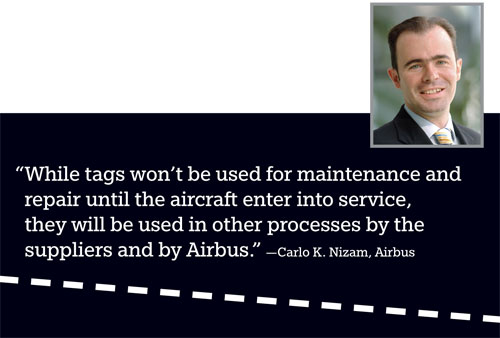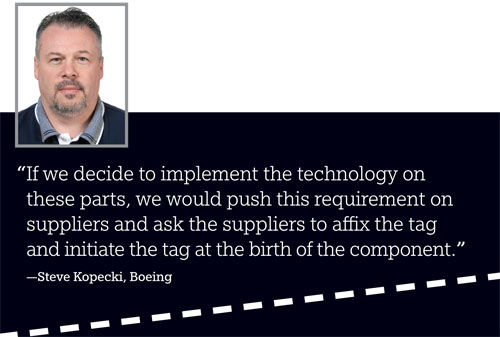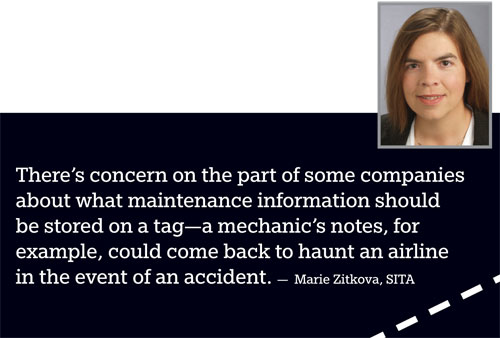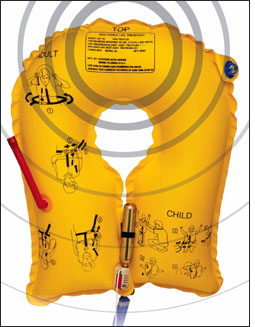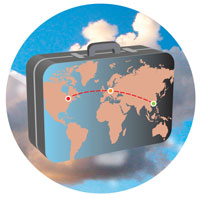Apr 01, 2010For the past six years, the world's two dominant commercial airplane manufacturers—the U.S.-based Boeing and Airbus, headquartered in France—have been on a mission to promote the adoption of industry standards for marking individual parts, keeping maintenance records on RFID tags and sharing related data. Beginning in 2004, the two companies held industry forums in North America, Europe and Asia, inviting the world's airlines, parts suppliers, regulatory agencies, and third-party maintenance, repair and overhaul (MRO) providers.
The goal was to prove that RFID could provide major benefits throughout the aerospace industry. Manufacturers would get visibility into production demands and reduce parts inventory. Suppliers could improve manufacturing efficiencies and verify the authenticity of their parts to fight counterfeiting. Airlines and maintenance companies could make MRO operations, largely paper-based, more efficient so spare parts could be located more quickly, reducing flight delays and cancellations, and potentially saving hundreds of millions of dollars each year.
At times, it seemed more like "mission impossible." In 2005, Boeing announced it would ask suppliers to RFID-tag thousands of parts used to make its 787 Dreamliner passenger planes. But technology providers were challenged by Boeing's request to develop and produce a high-memory tag with a 64-kilobyte chip that could hold original data and serial numbers for parts, maintenance records and potentially even photos and repair manuals.
Airbus, meanwhile, took a different approach. The company developed a three-phase plan to use RFID companywide to increase the accuracy, control and efficiency of processes through real-time automated visibility—and parts marking fell into phase three. The approach has paid off, and today many cite Airbus as a prime example of how organizations should deploy the technology.
As part of phase one, which includes supply-chain tracking, warehouse logistics and distribution, Airbus started RFID-tagging containers of parts needed to build the cabins in its A380 passenger planes, to ensure the right parts were delivered to the correct assembly stations at the proper time. Phase two, which covers global transportation, manufacturing and assembly processes, included tracking jigs—frames that hold large airplane sections—transported via cargo planes between the company's manufacturing and assembly facilities to improve production schedules.
The news in January that Airbus signed a seven-year contract with a supplier of high-memory, passive EPC Gen 2 RFID tags indicates that Airbus is now ready for phase three. By the end of this year, Airbus officials say some suppliers may be required to apply RFID tags to airplane components for its A350 extra wide-body (XWB) airplane at the source of manufacture. Those tags will store data such as a "birth record" detailing information about a part's initial construction. Up to 3,000 different RFID-tagged parts—half of which will require high-memory tags—will be assembled onto the A350 XWB. After the planes are delivered into service starting in 2013, airlines can begin using the high-memory tags to store maintenance histories directly on certain flyable aircraft parts and components. The data could be used to improve a host of processes, including configuration management, repair operations and warehouse logistics.
While airlines will have to wait a few years to achieve those benefits, aircraft manufacturers and suppliers will realize gains sooner. "The key message here is that while tags won't be used for maintenance and repair until the aircraft enter into service," Nizam says, "they will be used in other processes by the suppliers when they build them, and by Airbus when we install the parts."
Developments Converge
Although Boeing's RFID plans for the Dreamliner were sidetracked, the company has been testing and deploying RFID internally to better track tools and other assets, automate processes and reduce costs. A recent pilot, for example, in the assembly of overhead rests, on which flight crews sleep during international flights, found the technology could increase asset visibility, reduce error rates and improve technician process efficiency.
In the past year, technology and standards developments have helped put Boeing's RFID strategy for parts marking back on track. "We still see value in the technology, and we consider it ready to deploy," says Steve Kopecki, program manager for research, development and technology integration for Boeing's GoldCare business unit, a fleet-management service developed for several Boeing fleets. "We are preparing, within the first quarter of 2010, a full report to the Boeing CAS [Commercial Aviation Services] internal leadership team and to the 787 leadership team, to validate operational readiness. Following those meetings, decisions will be made regarding deployment on a Boeing platform."
Standards: In June 2009, the Air Transport Association (ATA), an airline trade group, published RFID standards in its "Spec 2000" manual. ATA developed a consensus among aircraft manufacturers, parts suppliers, airlines and maintenance organizations, and approved a data structure regarding what information should be stored on tags used on parts—including where, when and by which company a part was made, the part number and the serial number, as well as repair and maintenance information, where applicable.
Tags: The standards allow for both low-memory (512 kilobit) and high-memory (4 kilobyte up to 64 kilobyte) tags, and there is growing recognition in the industry that different levels of memory may be used to mark different parts. Both low- and high-memory tags will contain each part's birth record (part and serial numbers, date of manufacture and supplier name). High-memory tags will also have "current data" about the items to which they are attached—they'll note if a part has been repaired or modified with new software, for instance. In addition, there will be an open area of the tag's memory for users to add information, such as notes by a mechanic who services the parts. "Some companies believe that putting additional information on the tag will help their processes, while others believe that having a tagged part capture the birth record is sufficient," says ATA spokeswoman Elizabeth Merida. "The ATA spec supports both."
"One size does not fit all when it comes to RFID," says Phil Coop, manager of Boeing's GoldCare services department for the Dreamliner and other fleets. Boeing verified the need for higher-memory tags during workshops in Japan—held jointly with its technology partner, Fujitsu, and Japan Airlines, All Nippon Airways, Mitsubishi Heavy Industries, Kawasaki Heavy Industries, Fuji Heavy Industries, Japan Air Self-Defense Force and others—during which they used RFID to map the life cycle of a 777 entry door from initial manufacturing to retirement, and identified the maintenance processes that could be improved through the use of RFID. "Before we deploy any technology, however, we'll consider what the right tool for the right job is, based on a set of technology assessment criteria we created that takes all things into consideration," Coop says.
Technology packages: RFID technology vendors have responded to the aerospace industry's unique needs—not only for high-memory tags but infrastructure, software and data services. Several companies now offer high-memory tags, and many are working to increase the amount of memory offered. In addition, to help suppliers quickly start tagging parts and components—and gain internal benefits from their RFID deployments—Airbus and Boeing have been negotiating bulk technology prices with vendors for supply-chain partners. Some vendors, such as Fujitsu, have been packaging full technology solutions to help suppliers quickly deploy RFID. Fujitsu has developed an Automated Identification Technology system consisting of high-memory tags, RFID interrogators, middleware and related data and IT services, compliant with the Spec 2000 RFID standards. "We found out that there were many kinds of RFID technology available, but no one offered the total solution," says Toshiya Sato, Fujitsu's general manager for global solutions. In the past, customers had to buy RFID tags, interrogators and software from different companies.
From the beginning, both Airbus and Boeing understood the key role suppliers would play in their parts-marking solutions. After all, the burden for marking parts would fall on the suppliers' shoulders. In some other industries, supplier unease about the cost and hassle of RFID tagging has undermined efforts to deploy the technology in the supply chain. Airbus and Boeing share 70 percent of their suppliers, and many of these suppliers also make parts and components for defense aircraft. Since 2005, the U.S. Department of Defense has been contracting with suppliers—including some in the aerospace field—to provide goods in RFID-tagged cases and pallets.
Instead of imposing tagging mandates on suppliers, Airbus and Boeing believed it was better to first demonstrate how RFID led to process efficiencies and cost savings in their own business. But Airbus suppliers have been on notice that requirements were coming since the company issued specifications at the end of 2008, setting out the criteria for using low- and high-memory RFID tags to track 3,000 parts on the A350 XWB. "It's been in circulation publicly with our suppliers for over a year now," Nizam says. When asked if suppliers are required to use RFID, he responds: "The answer is, 'Yes.'"
Boeing no longer steers clear of the term "mandate" when discussing the requirement for suppliers to RFID-tag parts for the Dreamliner or any other airplane. "That would be the plan," Kopecki says, when asked about possible mandates. "If we decide to implement the technology on these parts, we would push this requirement on suppliers, and ask the suppliers to affix the tag and initiate the tag at the birth of the component."
Some aerospace suppliers, both large and small, are finally getting the message that RFID technology could help them gain more visibility and efficiency in their own manufacturing processes. Killdeer Mountain Manufacturing (KMM), a family-owned, 330-employee manufacturer of circuit cards, cable harnesses and other aerospace components, introduced an RFID system to track work in process (WIP) for its cable harness product line, which Boeing uses in the assembly of its F-15 fighter jets. The $4 million project was funded by the U.S. Air Force and developed by KMM, Boeing, the Air Force Manufacturing Technology Division, Alien Technology, Microsoft, RFID Global Solution and others.
"Automated data related to parts marking and quality assurance is part of the driver, but it's also the fact that we were looking to take that next generation of manufacturing supply-chain technology and use it to gain transparency and cost savings," says KMM VP Kristin Hedger. "It enables just-in-time business practices so our customers can see exactly where we are in our process."
The key goal of the program—dubbed RFID Supply Chain Optimization Universal Toolkit (SCOUT)—was to create a clear view of KMM's inventory and manufacturing processes. The results have helped save the company more than $160,000 a year on its F-15 production line by reducing average cycle time, WIP and the amount of floor space needed for the production of cable harnesses by one-third—enabling the company to relocate employees, equipment and tools to other projects. The pilot participants plan to make SCOUT available to other small- and medium-size aerospace contract manufacturers; the WIP software is already available from RFID Global Solution.
One of the strongest arguments for deploying RFID in the aerospace industry is that it could help assure the safety of aircraft that transport millions of passengers worldwide each day. As planes fly from one location to another, parts marking means a maintenance record would be stored on each serviceable part. That would allow, for instance, a mechanic in Paris to see what repairs a mechanic in San Francisco made on a part the previous day.
"Think about the impact of what happens when a part goes awry—it could cause a major catastrophe," says Michael Liard, ABI Research's practice director for RFID. "What you want to do is dot the 'i's and cross the 't's when it comes to airline safety. People's lives are depending on it, so why not use the most enabling technology available on the market today to help facilitate this paper-heavy process?"
That can't happen until all parties agree on a standard for data sharing between airlines, airplane manufacturers, parts suppliers and third-party MROs. "Although Spec 2000 defines the data, it's not shared in any standard way now," says Jon Andresen, a former United Airlines executive who founded the Technology Solutions consulting and software development firm, and works with Boeing and other companies on RFID. Industry stakeholders, he says, "need to continue to refine what data we keep and what data we share that will benefit both parties. Right now, it's shared sporadically and semi-manually. Yes, the data is in a computer system, but it's not a common business practice to share the data with each other. Visibility first, and then life-cycle traceability, are common goals for the industry."
Due to the competitive nature of the aerospace industry, data sharing continues to be a sensitive point, and so does the question of what data should be kept. Marie Zitkova, senior product manager for technology and innovation at SITA, a technology provider to the airline industry, says there's concern on the part of some companies about what maintenance information should be stored on a tag—a mechanic's notes, for example, could come back to haunt an airline in the event of an accident at a later date. "Companies want to make sure they can control and endorse what information is there, if there is the possibility of information being used in this context," Zitkova says.
Stakeholders continue to hold discussions through various industry groups and standards bodies about what data should be recorded on RFID tags, to what extent the information should be shared and under what conditions. There are two ways the sharing can be facilitated, according to Zitkova, who says SITA has demonstrated these techniques to airlines in its technology lab. One is that the information is recorded on, and sent on, the RFID tag, "like a letter in an envelope," Zitkova says. The other, which appears more appealing to some industry players, is to send an RFID tag that has point identifiers recording RFID events, such as maintenance, so a party with a justified interest can go back and request more information about the maintenance work that's been done.
While RFID parts marking for new Airbus and Boeing airplanes is likely to start this year, there's still the issue of commercial airplanes already in use, many of which have a 30-year to 40-year lifespan. Some believe airlines, MROs and other industry players will start to retrofit parts with RFID tags in the near future. "At the moment, only the true visionaries are moving forward," says David Puleston, VP of marketing for Tego, the RFID chipmaker that Airbus selected. "There are compelling use cases out there, and the organizations that are deploying high-memory RFID expect to get a measurable benefit. That will be a catalytic event for establishing similar benefits in the retrofit market.
"It's set up so that it's not complicated to deploy," he adds, noting that industry standards combined with tools the company now offers will help organizations encode and decode tags for both new and retrofit applications. "We've made it easy for companies considering adoption."
Airlines are required by the Federal Aviation Administration (FAA) and other international regulatory bodies to provide life vests within reach of every passenger on planes traveling overseas. The problem is, some passengers steal the vests—as many as 2,000 vests disappear from some international airlines yearly. Each vest costs roughly $50, but a bigger concern for many airlines is that they could violate international regulations and risk fines if they were to fly without the required number of vests.
The solution? Airlines are embracing RFID to reduce the time it takes to verify that these safety devices are under each airplane seat. Since July 2009, Eastern Aero Marine (EAM), a Miami-based supplier of safety gear for airlines and marine vessels, has been embedding passive UHF Gen 2 RFID tags in the 200,000 life vests it produces annually for the aviation industry. Air France is among the companies that have purchased the tagged vests and are using handheld RFID readers to conduct daily inspections.
The RFID-tagged vests can also help airlines more efficiently meet requirements to maintain and inspect life vests regularly. Each tag is encoded with information about when maintenance is required. Some vests must be removed, inspected and tested every five years or 10 years.
"Some airlines check the life vests on the morning before the first flight and some check after each flight," says Eloy Leal, EAM's director of operations and engineering. "They check manually under each seat. That takes time. With RFID, they can scan the aircraft and cut down the maintenance cost and the time. You can inspect a 737 in under a minute."
What about reducing theft in the first place? Airlines can use a portable scanner developed to detect any vest leaving the plane with a passenger. "It's up to the airlines if they want to stop the passenger," Leal says. "But at least they would know that, for example, two vests were taken off the aircraft and need to be replaced."
EAM is also using RFID internally to track production of life vests, determine how many are in stock and ensure the correct quantities are shipped to customers. "There's no room for miscounts," Leal says. The company is exploring whether RFID technology can help airlines track other safety equipment it manufactures, such as life rafts, first-aid kits and survival kits.
Even before the global recession, airports and airlines worldwide suffered under financial strain, due, in part, to lost baggage, which costs the airline industry about $3 billion a year, according to the International Air Transport Association (IATA). Add to that the cost of lost dollies, misplaced unit load devices (ULDs) and catering trolleys left in foreign cities. Some have turned to RFID to help stem the loss.
In the past few years, airports from Hong Kong International to McCarran International Airport in Las Vegas and Portugal's Lisbon Airport have installed RFID-based baggage-handling systems that are reliable and efficient. In addition to saving time and money, using RFID to track baggage can improve security and increase system capacity. Toronto Pearson Airport, Canada's busiest hub, is installing an RFID system to track the 10,000 pieces of luggage it checks through security in its international terminal each day.
"This allows positive tracking through a long section of conveyors into our international bag room in Terminal 1," says Mike Riseborough, general manager of building and facilities maintenance for the Greater Toronto Airports Authority. It complements the existing technology used for bag tracking, reducing the number of bags that are escalated to the next screening level.
On another front, airports and airlines are adopting RFID to track costly equipment. Munich Airport, Europe's seventh busiest airport, uses RFID to track freight dollies. The system prevents delays due to misplaced or lost dollies, improves asset management and optimizes maintenance processes. In addition, the airport can charge cargo companies more accurately for their use of rented dollies. At Paris-Charles De Gaulle Airport, Air France-KLM uses RFID tags to track ULDs, the large containers that are filled with baggage and cargo and loaded onto planes. And KLM's CityHopper subsidiary's catering arm deployed RFID after a 2008 pilot found that tracking catering trolleys enabled it to reduce the number of trolleys needed by 15 percent.
Other airlines are considering innovative RFID applications to regain the loyalty of passengers fed up with poor service. At 26 airports throughout New Zealand, Air New Zealand is offering 100,000 frequent fliers access to an RFID-enabled ePass system for self-scanned check-in and boarding services. The technology has "sped up the check-in process, reduced queues and significantly decreased waiting time for customers," says Air New Zealand's CIO Julia Raue.
United Airlines—together with Star Alliance, a global airline network, and the Transportation Security Agency—tested an RFID system to speed baggage and passenger check-in for frequent flyers at Chicago's O'Hare International Airport. And France's Nice Côte d'Azur Airport tested a Pass & Fly system, based on Near-Field Communication (NFC) technology. Air France frequent flyers used NFC-enabled mobile phones to speed and simplify passenger identification, security checks and the awarding of airport loyalty points.
While these niche applications show promise, RFID will ultimately perform best when its adoption reaches critical mass for processes, such as baggage tracking among airports worldwide. An IATA committee focusing on improved global baggage tracking has been traveling to 80 airports that produce 80 percent of lost luggage reports, performing assessments and advising airport officials about steps they can take to improve tracking—including RFID adoption. ODIN Technologies, in December, published a report, "RFID Baggage Tag Benchmark," that estimates airlines and airports could effectively track luggage on international flights through Europe, North America and Asia using a single tag—and recoup their deployment costs within 18 months.


